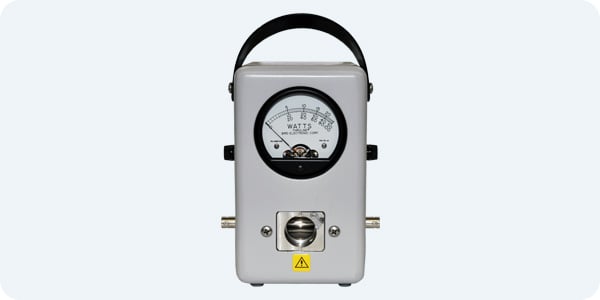
Search for topics or resources
Enter your search below and hit enter or click the search icon.
September 17th, 2025
2 min. read

The Bird Model 43 Wattmeter is one of the most trusted tools for measuring RF power. A common question we hear is: How do you read forward and reflected power correctly? The answer depends on the plug-in element (also called a “slug”) you’re using and the direction it is inserted.
Every Bird Plug-In Element has its frequency range and power rating printed right on the front (for example: (100 W, 400-1000 MHz).
That power rating is what determines which scale on the wattmeter face you’ll use when reading measurements. Always confirm the element’s label before taking a reading to ensure you’re on the right scale.

The Model 43 Wattmeter face has three fixed scales:
Bottom scale: 0 to 100, marked in increments of 20.
Middle scale: 0 to 50, marked in increments of 10.
Top scale: 0 to 25, marked in increments of 5 (even though “25” is not printed).
The key is to remember that the element’s power rating tells you which of these scales applies. In some cases, the same scale is reused — you simply “move the decimal point” to match the element’s rating.
Here’s a quick guide:
| Element Rating | Use Scale | Adjustment / How to Read |
|---|---|---|
| 1 W | 100 scale (bottom) | Move decimal 2 places left (100 → 1.00) |
| 10 W | 100 scale (bottom) | Move decimal 1 place left (100 → 10.0) |
| 100 W | 100 scale (bottom) | Read directly (100 → 100 W) |
| 1,000 W | 100 scale (bottom) | Multiply by 10 (100 → 1,000 W) |
| 10,000 W | 100 scale (bottom) | Multiply by 100 (100 → 10,000 W) |
| 5 W | 50 scale (middle) | Move decimal 1 place left (50 → 5 W) |
| 50 W | 50 scale (middle) | Read directly (50 → 50 W) |
| 500 W | 50 scale (middle) | Multiply by 10 (50 → 500 W) |
| 5,000 W | 50 scale (middle) | Multiply by 100 (50 → 5,000 W) |
| 25 W | 25 scale (top) | Read directly (25 → 25 W) |
| 250 W | 25 scale (top) | Multiply by 10 (25 → 250 W) |
| 2,500 W | 25 scale (top) | Multiply by 100 (25 → 2,500 W) |
Before taking a measurement, connect the wattmeter properly:
Input connector → attach your radio, transmitter, or RF signal generator.
Output connector → attach to a load or antenna.
⚠️ Make sure the wattmeter is oriented correctly, with the arrow on the element pointing in the direction of power flow (from the transmitter toward the load).
With the wattmeter connected in line, set the element so the arrow points in the direction of forward power (transmitter → load). Take your forward power reading.
To measure reflected power, rotate the element 180° so the arrow points back toward the transmitter.
Bird recommends using a separate element rated at about 10% of the forward power for reflected measurements.
Example:
If your forward power is 100 W, use a 10 W element to measure reflected power. This ensures the reflected reading is accurate and not lost in the lower end of a higher-rated scale.
Reading RF power on the Bird Model 43 Wattmeter comes down to three things:
Check your element to determine the correct scale.
Match the scale and adjust decimals.
Rotate the element to switch between forward and reflected measurements.
The Model 43 remains a trusted RF power meter worldwide because it’s simple, accurate, and adaptable—just rotate the element, and you’re ready to measure.
Watch how forward and reflected power readings help calculate VSWR —using the same trusted Bird wattmeter.
Michelle Specht is the Senior Product Manager at Bird Technologies, where she drives strategy and innovation across the Test & Measurement product line. With a background in Aerospace Engineering, Michelle bridges technical performance with customer needs, ensuring Bird’s wattmeters and RF solutions deliver practical value for technicians, engineers, and system operators.